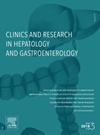低HER2表达对转移性胃癌患者临床病理特征及临床转归的影响
IF 2.4
4区 医学
Q2 GASTROENTEROLOGY & HEPATOLOGY
Clinics and research in hepatology and gastroenterology
Pub Date : 2025-07-01
DOI:10.1016/j.clinre.2025.102646
引用次数: 0
摘要
背景:转移性胃癌是一种极其致命的恶性疾病。人表皮生长因子受体2 (HER2)是HER2过表达或基因扩增患者的重要治疗靶点。然而,her2低表达的预后价值仍存在争议。本研究旨在探讨HER2表达水平对转移性胃癌患者临床病理特征及临床转归的影响。方法:研究纳入2011年1月至2023年1月诊断为新生或复发转移性胃癌的患者。我们根据HER2表达水平将患者分为三种类型:阴性、低水平和阳性。结果:目前的研究包括191例患者,其中99例(51.8%)为her2阴性,42例(22.2%)为her2低,50例(26.2%)为her2阳性。在胃食管交界处(25.3%、23.8%和44%)、印戒细胞癌(54.8%、44.4%和16%)、黏液细胞癌(40.9%、27.8%和12%)、肠型组织学(17.9%、50%和48.9%)、高癌胚抗原水平(34.5%、46.2%和56.5%)、bbb2转移部位(25.3%、45.2%和42%)、肝转移(33.3%、42.9%和66%)、腹膜转移(44.4%、28.6%和20%)、her2阴性组、her2低组和her2阳性组远处淋巴结转移率分别为53.5%、83.3%和58%。与her2阴性组相比,her2低组的中位总生存期(OS)相似(14.8个月vs 14.5个月,p = 0.868),但中位OS明显短于her2阳性组(14.8个月vs 18.6个月,p = 0.024)。结论:我们的研究结果表明,her2低转移性胃癌患者具有不同的临床和病理特征。与her2阳性组相比,her2低组的生存率较低可能是由于缺乏针对her2低疾病的有效靶向治疗。需要进一步的研究来制定针对这一亚群的具体治疗策略。本文章由计算机程序翻译,如有差异,请以英文原文为准。
The impact of low HER2 expression on clinicopathological features and clinical outcomes in patients with metastatic gastric cancer
Background
Metastatic gastric cancer (GC) is an extremely fatal malignant disease. Human epidermal growth factor receptor 2 (HER2) is an important therapeutic target in patients with HER2 overexpression or gene amplification. However, the prognostic value of HER2-low expression is still controversial. This study aims to investigate the effect of HER2 expression levels on clinicopathological characteristics and clinical outcomes in patients with metastatic GC.
Methods
The study included patients who had diagnosed de novo or recurrent metastatic GC from January 2011 to January 2023. We classified the patients into three categories based on their HER2 expression level: negative, low, and positive.
Results
The current study included 191 patients, with 99 (51.8 %) classified as HER2-negative, 42 (22.2 %) as HER2-low, and 50 (26.2 %) as HER2-positive. There were significant differences in the primary origin of gastroesophageal junction (25.3 %, 23.8 %, and 44 %), signet ring cell carcinoma (54.8 %, 44.4 %, and 16 %), mucinous cell carcinoma (40.9 %, 27.8 %, and 12 %), intestinal type histology (17.9 %, 50 %, and 48.9 %), high carcinoembryonic antigen level (34.5 %, 46.2 %, and 56.5 %), >2 metastatic sites (25.3 %, 45.2 %, and 42 %), liver metastasis (33.3 %, 42.9 %, and 66 %), peritoneal metastasis (44.4 %, 28.6 %, and 20 %), and distant lymph node metastasis (53.5 %, 83.3 %, and 58 %) among the HER2-negative, HER2-low, and HER2-positive groups, respectively. The HER2-low group had similar median overall survival (OS) compared to the HER2-negative group (14.8 vs. 14.5 months, p = 0.868), however, significantly shorter median OS than the HER2-positive group (14.8 vs. 18.6 months, p = 0.024).
Conclusions
Our findings demonstrated that patients with HER2-low metastatic GC had different clinical and pathological features. The poorer survival rates of the HER2-low group compared to the HER2-positive group might be due to the lack of effective targeted treatments for HER2-low disease. Further research is warranted to develop specific therapeutic strategies for this subgroup.
求助全文
通过发布文献求助,成功后即可免费获取论文全文。
去求助
来源期刊

Clinics and research in hepatology and gastroenterology
GASTROENTEROLOGY & HEPATOLOGY-
CiteScore
4.30
自引率
3.70%
发文量
198
审稿时长
42 days
期刊介绍:
Clinics and Research in Hepatology and Gastroenterology publishes high-quality original research papers in the field of hepatology and gastroenterology. The editors put the accent on rapid communication of new research and clinical developments and so called "hot topic" issues. Following a clear Editorial line, besides original articles and case reports, each issue features editorials, commentaries and reviews. The journal encourages research and discussion between all those involved in the specialty on an international level. All articles are peer reviewed by international experts, the articles in press are online and indexed in the international databases (Current Contents, Pubmed, Scopus, Science Direct).
Clinics and Research in Hepatology and Gastroenterology is a subscription journal (with optional open access), which allows you to publish your research without any cost to you (unless you proactively chose the open access option). Your article will be available to all researchers around the globe whose institution has a subscription to the journal.
 求助内容:
求助内容: 应助结果提醒方式:
应助结果提醒方式:


